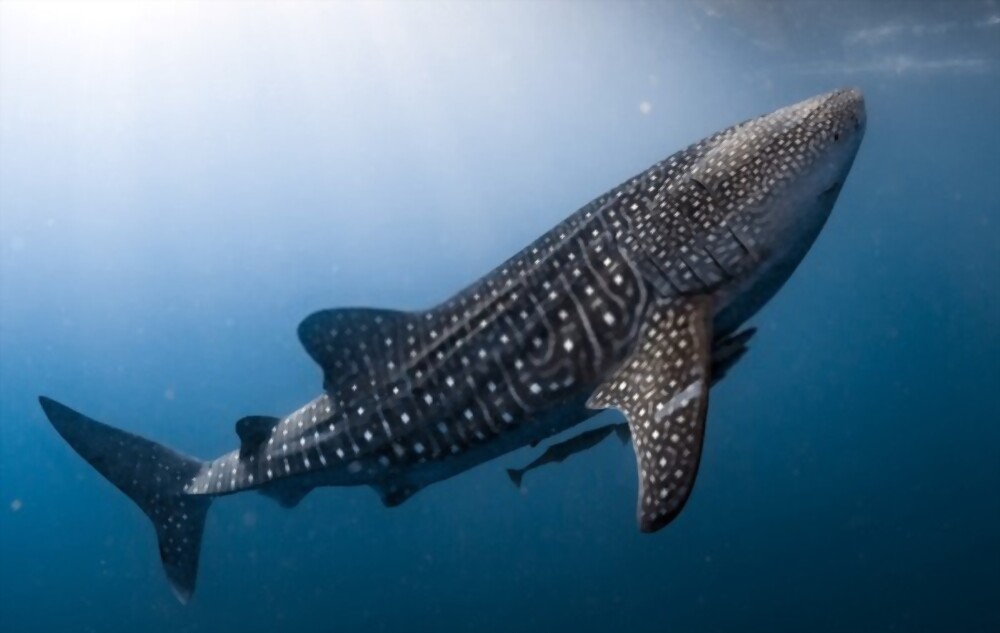Whale sharks (Rhincodon typus A. Smith, 1828) are the largest known living fish on earth, reaching up to 18 – 32.8 feet total in length and can weigh up to 20.6 tons. These massive sharks are cartilaginous fishes, from the class Chondrichthyes, subclass Elasmobranchii and are the only described member of the family Rhincodontidae. Whale sharks are also known as “carpet sharks” for their unique carpet like spot patterns and are covered with placoid scales, which are only found in sharks and rays. Although whale sharks are extremely larger in size, unlike other carnivorous shark species such as great white sharks and tiger sharks, whale sharks are filter feeders. Using “Cross – Flow Filtration”, whale sharks swim with their 4 feet wide mouth open to feed on planktons, small fishes, fish eggs and small marine creatures by filtering water through their 3000 tiny teeth and using their gill rakers. Hence, undoubtedly whale sharks are not a threat to human beings.
These giants can be found swimming long distances mainly in the tropical and subtropical oceans except Mediterranean seas, moving slowly to their feeding grounds in order to find an adequate amount of feed to maintain their massive bodies. Sometimes, they can be seen swimming in schools containing up to hundreds of whale sharks and capable of diving more than 1000 m deep in water. Often, these large sharks are spotted in open seas in the Atlantic Ocean, Caribbean Ocean as well as in the Indian Ocean. Whale sharks can be spotted around in Asian countries such as India, Malaysia, China, Japan as well as in Sri Lanka. Kalpitiya, Negambo, Galle, Mathara, Trinkomalee are some popular whale shark sighting locations in Sri Lanka.
Although the breeding and reproductive behaviors are not well observed, researchers believe that whale sharks take around 25 years to sexually mature and are ovoviviparous, giving birth to around 300 young whale sharks at a single time. Another fact is that usually, females are larger than males. According to recent research studies, there is an idea that the Arta area off Djibouti acts as a feeding ground or a raring area for some significant whale shark groups. Furthermore, marine biologists have discovered a three-way symbiotic relationship between whale sharks, echeneids (remoras) and a symbiotic copepod. They describe the whale shark – copepod relationship as a parasitic relationship with commensal or even mutualistic characteristics.
These massive creatures are listed as an endangered species by the IUCN 2016 (International Union for Conservation of Nature) and are considered as a protected marine fish in most countries including Sri Lanka. ( whale sharks are protected under the fisheries and aquatic resource act of Sri Lanka.)
Although these unique sharks are considered important and rare, Asian countries such as Taiwan, China, Philippines consume these whale shark fins, fresh or dried and salted since shark fins soups are considered as a luxury dish among mentioned countries. Other than that, whale sharks can be harmed by divers and vessels. Another considerable fact is that even though whale sharks have placoid scales all over their body, infections can happen on their mucus coverings if the mucus covering is damaged. Hence, touching and diving hanging on their fins are not good practices.
References
Rowat, D.R., Leblond, S.T., Pardigon, B., Vely, M., Jouannet, D. and Webster, I.A., 2016, May. Djibouti–a kindergarten for whale sharks?. In The 4th International Whale Shark Conference (Vol. 2016, No. 2, p. 54). Hamad bin Khalifa University Press (HBKU Press).
Tomita, T., Murakumo, K., Komoto, S., Dove, A., Kino, M., Miyamoto, K. and Toda, M., 2020. Armored eyes of the whale shark. Plos one, 15(6), p.e0235342.
Norman, B.M., Reynolds, S.D. and Morgan, D.L., 2021. Three-way symbiotic relationships in whale sharks. Pacific Conservation Biology.
Check This Out – Only Animal Makes Great White Sharks Tremble in Fear








